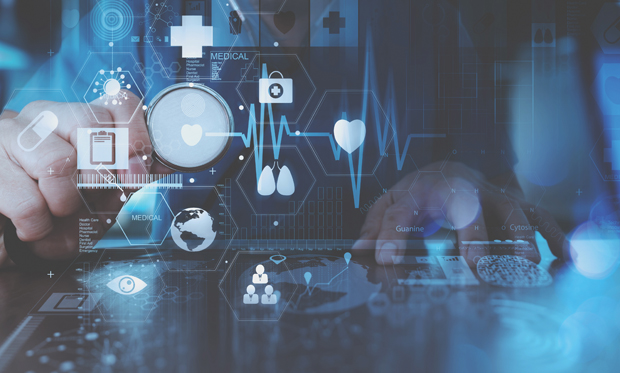Of the key technologies listed as “ready to propel industries and transform our world” in the 2017 report Top 50 Emerging Technologies: Growth Opportunities of Strategic Imperative, most fall under the scope of biomedical engineering (BME). Issued by the major market research and analysis company Frost and Sullivan [1], the report’s findings are no surprise to the researchers, clinicians, and others who are heavily invested in this field.

“I think we’re at a big tipping point,” says Leroy Hood, M.D., Ph.D., president and co-founder of the Institute for Systems Biology in Seattle, Washington, and chief science officer with Providence St. Joseph Health (Figure 1: Photo courtesy of the Institute for Systems Biology). “I like to say that what almost everyone is practicing today is old 20th century medicine, and what we’ll be practicing in the next ten years is 21st century medicine, which is medicine that recognizes that health care should be predictive, preventive, personalized, and participatory.” Biomedical technology, he asserts, will be at the forefront of this revolution in health care [2].

Health care will indeed look different in the future, agrees Daniel Kraft, M.D., chair for medicine at Singularity University in California and founder and chair of Exponential Medicine, an intensive, innovation-focused annual medical conference held in southern California (Figure 2: Photo courtesy of Singularity University, California). “As Bill Gates once said, we overestimate what will happen in a year or two and underestimate what will happen in a decade. And ten years from now, I think health care is going to shift from intermittent, reactive ‘sick care’ to much more continuous and proactive.” Kraft envisions digital health-care coach that accesses and evaluates a regular flow of sensor-gathered health data, as well as personal omics (from genome to microbiome), and provides a user-friendly summary from the individual’s smartphone and/or by leveraging augmented or virtual reality. Both individuals and their doctors can then use that actionable information to encourage wellness, more effectively screen for and diagnose diseases at early stages, tailor treatments, and manage acute and chronic illness better.
Building on Biosensors
Of the more than two dozen BME-related areas listed in the Frost and Sullivan report, several are especially noteworthy, according to the experts. These include biosensors. From a skin-mounted patch that analyzes sweat and provides “quantitative values for sweat rate, total sweat loss, pH, and concentration of chloride and lactate” [3] to an in-ear device for athletes that wirelessly and in real time tracks core body temperature, heart rate, maximum rate of oxygen consumption (VO2), speed, and distance [4], new sensor research as well as clinical and commercial products seem to be announced almost daily.’

“Increasingly sophisticated biosensors are already being integrated into our watches and smartphones and into the clothes we wear,” says Elazer Edelman, M.D., Ph.D., who directs both the Massachusetts Institute of Technology (MIT) Clinical Research Center and the Harvard-MIT Biomedical Engineering Center (Figure 3: Photo courtesy of Elazer Edelman). “In the future, if not already, sensors will do everything from perceiving motion to detecting blood-borne elements.” People won’t have to go to a laboratory for sporadic blood draws, electrocardiography, or other tests. Instead, wearable sensors will pick up a wide range of health parameters in a much more continuous fashion and while individuals go about their normal activities. Edelman remarks, “This idea is very attractive.”
For sensors to have a real impact on health care, they must not only collect behavioral and physiological data, but also make sense of them. “There’s a lot of buzz around the Internet of Things, and now the Internet of Medical Things, where we are collecting data that we could never have accessed in the past and starting to really use them,” Kraft says. As an example, he points to his Apple Watch 3, which features a sensor that “does a pretty high-fidelity job of tracking heart rate, and also it can actually send me an alert if my heart rate stays elevated when I’m not being active, which can be an indication of a heart arrhythmia.” The connected home is coming, too, he says. It will have the ability to track an individual’s sleep or vital signs via Wi-Fi alone to provide insight into the person’s normal baseline, and to note inconsistencies or changes that could portend health problems. “The challenge with biosensors is to combine the data they collect and make them useful [by] leveraging machine learning and artificial intelligence,” Kraft observes. He used the analogy of a modern automobile. “No one wants to look at the data from the 300 sensors in a car that measure temperature, oil level, and on and on, so, instead, via software algorithms, when issues arrive—hopefully early—a ‘check engine’ light goes on.” With biosensors, biomedical engineers similarly need to blend all the sensor-driven and other health-related data into actionable information. In other words, he describes, “As a patient, clinician, or biotechnologist, you can see that ‘check engine’ light go on before the patient has blown a gasket, so to speak. This is about convergence and fusion of sensors, data (ideally, crowdsourced, as we do with Google Maps), analytics, where it’s not just electrical engineering or software or widgets. It’s the blending of all those and more, and with BME at the center.”
Other Key Areas
Another major BME-related advance is the advent of high-resolution, rapid imaging techniques that operate in vivo, Edelman says. “I’m talking about anatomic, molecular, and functional imaging that allows you to discriminate not just structures but also distinguish metabolic and chemical aspects revealing the way tissues or organs are behaving.”
Hood sees the big imaging push as advancing nuclear magnetic resonance instruments that expose the activities of key molecules and at key locations. Chemical analyses of the approximately 20,000 human proteins will divulge when they are turned on or off. Even more importantly, he says, they will quantitatively reveal their levels of expression. The latter will allow the assessment of metabolites as well. “The ability to measure the clinical chemistries that associate with health and disease states, and to extend the repertoire of those clinical chemistries, is a really important area, and one that will require [contributions from] microfluidics, nanotechnology, and miniaturized assays,” Hood notes.
In addition, Hood is excited about powerful new assays called protein catalyzed capture (PCC) agents, which bind to target molecules. Now under development by Indi Molecular of Culver City, California, the agents are based on the work of James Heath and his laboratory at the California Institute of Technology, Pasadena [5], [6]. “These are aptamer peptide-based reagents that I think have a real chance of replacing monoclonal antibodies, which have a number of limitations: 1) monoclonal antibodies are incredibly unstable, 2) they exhibit enormous cross-reactivity, and 3) they are often dependent on living animals or living tissue culture cells,” Hood says. Substituting monoclonal antibodies with PCC agents will be a transformational event, he notes, because “not only will you be able to use these for in utero and in vitro diagnoses, but you will also be able to use them as therapeutic drugs.”
For Kraft, additive manufacturing is a technology that runs through many areas of BME and health care. “It’s possible to scan a fractured arm and 3-D print a splint or cast. In some cases, casts are also being integrated with sensors so we can tell when and how a person is wearing it,” he notes. In addition, he adds, “low-cost devices are available to scan a child who has a missing limb and do it from any location in the world, including developing countries; remotely and inexpensively print a basic prosthetic that matches the child’s anatomy; and then build new versions of the prosthetic as the child grows.”
Other applications include 3-D printing of microfluidics, which can be used to make a lab-on-a-chip or to generate increasingly small instrumentation that can be deployed in sensors and other devices inside the body. In addition, stem cells may be added to 3-D printing capabilities to generate personalized tissues, including trachea grafts. Kraft adds, “There’s even the idea of printing medical devices right in the operating room, so surgeons can do personalized hip and knee implants for orthopedic surgery.
Coming Together
Whether it is 3-D printing, biosensor advances, PCC agents, imaging, or any of the other emerging BME technologies listed in the Frost and Sullivan report, all have something in common: the innovators must themselves take the time to really learn biology, Hood says. “Bioengineers do learn some biology through their education, but there isn’t an emphasis on a really deep understanding, and bioengineers need to learn biology deeply because, in the end, biology should drive the technology. It shouldn’t just be smart engineers saying, ‘Voila! Here’s a really neat idea,’” he continues. “There is infinite space in which to insert technology, so we need to invest in relevant technology, and, to do that, we need to understand the biology in which the relevant technology is going to be embedded.”
That’s not to say that one person can or should try to do it all. These BME technologies demand wide-ranging input, Kraft asserts. “The future of health care requires cross-disciplinary work between biomedical engineers, genomic experts, digital health entrepreneurs, folks doing nanotech and robotics, [and must include] patients and caregivers. We need to blend fields and leverage fast-moving technologies as a way to really impact not only health care here in the United States, but also in less affluent parts of the world,” he remarks.
This melding of approaches and technologies is highlighted in the global competition called Medical Tricorder XPRIZE, according to Kraft, who helped design the prize. The newly awarded XPRIZE in 2017 challenged research teams to develop diagnostic devices inspired by the fictional “tricorder” in the 1960s Star Trek television series. “The winning team was led by an emergency-medicine doctor and a biomedical engineer, and his engineering siblings, and this project converged technologies together,” Kraft explains. Developed over several years, their entry was an artificial intelligence-enhanced system that integrates knowledge gained through clinical emergency medicine with physiological data collected from patients via noninvasive sensors, and yields diagnostic assessments [7]. A new Cancer XPRIZE competition [8] is now in the works, he adds. “This is going to be a multimillion-dollar prize to incentivize the development of accurate, affordable, reliable, and low-cost cancer screening anywhere in the world, and we’d love folks from the BME community to participate in that, as well.”
BME innovation will certainly shape the future of health care, Edelman remarks. “I don’t think, however, that I can truly envision what the world will be like five years from now, because I don’t think I could have imagined five years ago what the world is like today. But I am absolutely sure that it will be different, that medicine will be more effective, and that practicing medicine will be more efficient.”
One of the biggest changes coming to medicine will be the elevation of wellness to a dominant feature of health care, Hood says. “By gathering different data types and longitudinal data to make enormously detailed 360° surveys of an individual, and using machine learning, artificial intelligence, and deep learning to analyze those data, we can make actionable recommendations that will allow an individual to improve wellness or avoid disease.”
This type of systems approach to health care affords an understanding of how different biological networks are involved in wellness, reveals how perturbations of those networks can cause disease, and yields diagnostic markers for early detection of disease as well as therapeutic targets to fight and possibly reverse disease. Hood concludes, “This revolution is coming, and it will be fueled by BME technologies.”
References
- Frost and Sullivan. (2017, Mar.). Top 50 emerging technologies: Growth opportunities of strategic imperative—Multi-billion dollar technologies ready to propel industries and transform our world. Tech Vision. [Online].
- L. Hood. (2016). P4 medicine and scientific wellness: Catalyzing a revolution in 21st century healthcare. Institute for Systems Biology Annual Report. [Online].
- A. Koh, D. Kang, Y. Xue, S. Lee, R. M. Pielak, J. Kim, T. Hwang, S. Min, A. Banks, P. Bastien, M. C. Manco, L. Wang, K. R. Ammann, K.-I. Jang, P. Won, S. Han, R. Ghaffari, U. Paik, M. J. Slepian, G. Balooch, Y. Huang, and J. A. Rogers, “A soft, wearable microfluidic device for the capture, storage, and colorimetric sensing of sweat,” IEEE Sci. Transl. Med., vol. 8, no. 366, pp. 366ra165, Nov. 2016.
- L. Marsh. (2017, Oct. 28). Bodytrak. [Online].
- M. B. Coppock, C. R. Warner, B. Dorsey, J. A. Orlicki, D. A. Sarkes, B. T. Lai, S. M. Pitram, R. D. Rohde, J. Malette, J. A. Wilson, P. Kearney, K. C. Fang, S. M. Law, S. L. Candelario, B. Farrow, A. S. Finch, H. D. Agnew, J. R. Heath, and D. N. Stratis-Cullum, “Protein catalyzed capture agents with tailored performance for in vitro and in vivo applications,” Peptide Sci., vol. 108, no. 2, pp. e22934, Mar. 2017. [Online].
- A.A. Luderer. (2017, Oct. 28). Antibodies are analog: PCCs are digital. Indi Molecular. [Online].
- Qualcomm Tricorder. (2017, Apr. 13). Family-led team takes top prize in Qualcomm Tricorder XPRIZE competition for consumer medical device inspired by Star Trek. XPRIZE. [Online].
- XPRIZE. (2017, Oct. 30). The cancer XPRIZE goal 2017. XPRIZE Cancer. [Online].



